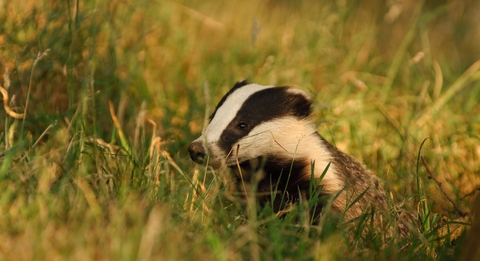While we have had as many as 26 people out on a bat walk at the Great Fen in the past, due to COVID-19 restrictions, only a small group of 5 people join me on a bat survey of Woodwalton Fen National Nature Reserve this year.
This provided a chance for a few members of the public to see how we carry out some of our monitoring and research work at the Great Fen. It was also a chance to take part themselves, using electronic bat detectors to report to me what they were hearing as we walked the reed-fringed paths of this fabulous nature reserve.
Those people who joined me came from both the Cambridge and Wisbech areas, and after some instruction on how to use the bat detectors, we ventured forth into the Fen. One young 'bat enthusiast' was already brandishing his own detector, a birthday present after attending a previous years' bat walk.
On the way to the Rothschild’s Bungalow, the calls of dark bush-crickets provided a useful opportunity to test out the detectors. Other insects were on the wing, food to lure the bats out. These included moths, which can be very numerous in the Great Fen in both species and number of individuals, with 850 moths of over 50 species being identified in one night by our recent surveys.
The echolocations of common pipistrelle bats were picked up first, and these bats were detected around most of the route. At the famous Rothschild ‘bungalow on stilts', yet more pipistrelles were encountered, still visible against a darkening sky; circling the bungalow, under the towering oaks. This was chosen as one of the evenings' ‘wildlife highlights’ for some in the group.
As we headed south, the barks of Chinese water deer, carried across to us from the west side of the Fen. Once we reached the area containing the meres, this provided additional bat activity, with more pipistrelles being detected; most likely feeding over the water of these shallow lakes. As the bird hides are currently closed at Woodwalton Fen, we listened in to common pipistrelles flying to and from the meres, along the paths leading up to them.
More bush-crickets were detected, including short-winged coneheads, which have been seen earlier this year, on dragonfly walks. An oak bush-cricket was also a nice find, as this species is normally living up in the trees. It was rather pale in colour, as it had probably shed its skin recently. It was found walking across the path in front of us, and as it was moving rather slowly, it was easy to take turns to observe it more closely. It turned out to be a female, its long, sword-like like egg-laying ‘ovipositor’, extending out behind its body.
As we made our way towards the Great Raveley Drain, a rare barbastelle bat was detected. This was not a surprise, as regular monitoring has identified this species as being present on site in the more wooded parts of the reserve, which is where we were.
Bat activity increased again as we reached the drain, the water providing plenty of opportunities for them to feed and drink, as well as being a commuting route, up the east side of the Great Fen. Noctule, one of our biggest bats, was heard several times; a species that you can see on previous twitter posting.
The echolocations and social calls of pipistrelles persisted all along the Great Raveley Drain, back to the start of the walk. They were also joined by the calls of stirring tawny owls, adding to the soundscape, as a huge red moon rose in the east, over the adjacent farmland. Not surprisingly, this proved to be another highlight for the group.
Back at the entrance bridge, we had yet more close encounters with bats, as we looked down over the water. We then said our goodbyes, but this was not the end of the mammal encounters; one family enjoyed seeing a badger trundle along the road as they left for home - it is these sort of unexpected sightings that makes the Great Fen such a great place to visit.

